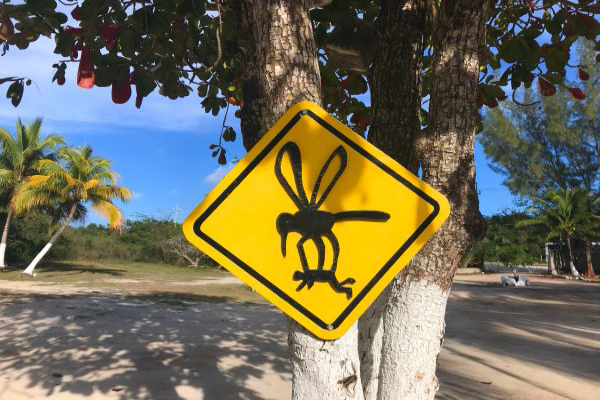
Mosquito Joe explains the world's largest mosquito, the Toxorhynchites species.
|
Ahh, mosquitoes. If you’re not a fan of these pesky pests, we understand your frustration. From buzzing in our ears to leaving itchy bites on our skin, they sure know how to make their presence known.
But if you’re someone who is fascinated by them (like your local pros at Mosquito Joe®!), you might be interested to know that some 46 million years ago, mosquitoes weren’t much different in size than they are today. With well over 3,500 species of mosquitoes in the world, it raises the question: what is the biggest mosquito species out in the wild?
The Australian Elephant Mosquito (Toxorhynchites speciosus)
When you think of Australian wildlife, you probably picture some of the world’s most enormous creatures. From large crocodiles to spiders that look like they jumped out of a horror movie and some of the biggest winged rodents you would ever encounter, it’s no surprise Australia is also home to the world’s largest mosquito species, the Australian elephant mosquito.
Everything You Need to Know About Australian Elephant Mosquitoes
Australian elephant mosquitoes are one of the largest mosquito species in the world, with adults growing up to 1½ inches in length. Sure, on paper, that may seem relatively small, but considering the most common mosquitoes are between 0.15 and 0.4 inches long, with some less than 0.1 inches long, it’s easy to see why they rank as the world’s largest mosquitoes. Their elongated bodies and slender legs stand out from other mosquito species – especially when you add in their 4-inch wingspan.
In addition to their size, elephant mosquitoes are known for their striking appearance and often come in a variety of colors and patterns, featuring blue, white, or gold across their bodies. How fancy!
A Friendly Mosquito?
You can breathe a sigh of relief because there’s no need to worry about the biggest mosquito in the world biting you. Despite their intimidating presence, Australian elephant mosquitoes do not feed on human blood. Instead, they sweetly sustain themselves by feeding on plant sap or flower nectar.
While the Australian elephant mosquito is predominantly native to its namesake continent, it can also be found in southeastern parts of the U.S., like Kansas and Oklahoma. These mosquitoes thrive in damp habitats, including wetlands, swamps, or water-filled containers.
Elephant mosquitoes often choose areas such as tree holes, discarded tires, or old flower pots to lay their eggs. They fly in a counterclockwise pattern to deposit their eggs once they have found a safe place. Although adult elephant mosquitoes are herbivores, their larvae are cannibals, preying on each other as well as the larvae of other aquatic species or nearby bacteria and algae.
Since these larvae can eat thousands of other larvae daily, scientists have tried introducing elephant mosquitoes as control agents for other dangerous mosquito species that carry diseases. However, this conservation effort has been met with limited success.
Other Contenders in the Mosquito Size War
The Gallinipper Mosquito
Although elephant mosquitoes are the biggest mosquito in the world, the Gallinipper mosquito is often called the “monster” mosquito as it’s the largest biting mosquito in the U.S. You don’t want these guys snacking on you – their bite contains salvia with an anticoagulant that can cause severe allergic reactions in some people.
Their nickname is an appropriate moniker as the Gallinipper mosquito ranges from about ½ to 1 inches in size, with a wingspan of up to 9mm. On top of that, they can fly up to 20 miles per hour, which is as fast as a coyote!
Despite having the title of the largest blood-sucking mosquito found in the U.S., this species isn’t known for carrying mosquito-borne diseases. However, you will want to watch out for this pest if you live in eastern states, South Dakota, or Texas.
The Asian Tiger Mosquito
Another aggressive mosquito you should be wary of is the Asian tiger mosquito. They made their way to the U.S. from Asia in the 1980s and can be found in parts of California. Featuring distinct black-and-white patterns on their bodies, they can also grow roughly 0.08 and 0.39 inches long, with males averaging 20% smaller than females.
Known for being a particularly aggressive and feisty biter, they’re much more active during the day and prefer areas with lots of shade. They’re commonly found in much more Southeastern regions of the United States, from Texas to New Jersey.
Protect Yourself from Mosquitoes, Big or Small
Protecting yourself from mosquitoes is essential, whether it’s the world’s biggest mosquito or your everyday house pest. Besides their annoying bite, they can also carry harmful diseases like the West Nile virus.
Rather than dealing with these issues on your own, enlist the help of Mosquito Joe. Known for offering the best mosquito control in the business, you can also count on us for a range of other pest control services. With our support, our local service professionals can help you fight your mosquito problem 24/7, thanks to our automatic mosquito misting system.
And because we stand by our word, you can count on our Neighborly Done Right Promise®, which means everything we do is completed to your total satisfaction. Even small mosquitoes can cause big problems for you. Don’t let them ruin your outdoor fun; call your local pest control pros at Mosquito Joe and request a free quote today!
